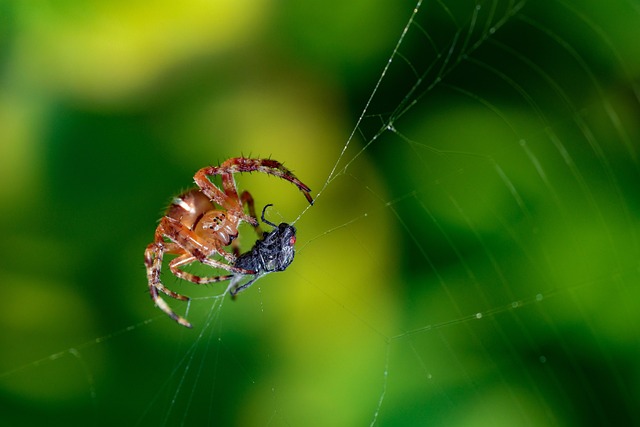Understanding spider behavior is key to implementing eco-friendly spider control methods that minimize environmental impact. By studying web construction, prey selection, and territorial habits, professionals can employ targeted strategies like non-toxic repellents, essential oils, natural pheromones, and strategic trap placement. Chemical pesticides, while effective, pose ecological and health risks, prompting a shift towards sustainable solutions. Modern techniques include mechanical spider traps, Integrated Pest Management (IPM) focusing on biological controls, habitat manipulation to encourage beneficial species, and early detection systems. These eco-friendly spider control methods promote coexistence with spiders while preserving ecosystem balance.
In many settings, spiders are both beneficial insects that help control pests and potential health hazards due to their webs. This article explores advanced solutions for managing spider populations and webs in a way that’s safe for humans, pets, and the environment—what we refer to as eco-friendly spider control. We delve into understanding spider behavior, comparing traditional techniques with advanced methods, highlighting innovative eco-conscious tools, and implementing sustainable long-term strategies.
Understanding Spider Behavior: Key to Eco-Friendly Control
Understanding Spider Behavior: The Cornerstone of Eco-Friendly Control
Spiders are intricate creatures with unique behaviors that play a vital role in ecosystems. To implement effective and eco-friendly spider control, it’s essential to grasp their behavior patterns. These arachnids have specific web construction preferences, prey selection, and territorial habits. By studying these behaviors, professionals can develop targeted strategies that minimize harm to both the spiders and the environment.
Knowledge of spider behavior allows for the use of non-toxic repellents and deterrents, such as essential oils and natural pheromones, which disrupt their web-building and navigation without causing lasting damage. Additionally, it enables the implementation of physical control methods that respect natural cycles, like carefully timed lighting adjustments to disrupt their activity or the strategic placement of traps to capture spiders without harming them.
Traditional vs. Advanced Spider Management Techniques
In the realm of spider management, traditional techniques have long been the go-to approach, often involving chemical pesticides that can have harmful environmental and health impacts. These methods may offer quick results, but they are not sustainable or eco-friendly. The quest for advanced solutions has led to a shift towards more sophisticated and nature-inspired strategies.
Advanced spider management techniques prioritize eco-friendly control, focusing on prevention, exclusion, and the use of biological agents. These innovative approaches include implementing physical barriers, regularly cleaning and maintaining spaces, introducing natural predators like spiders’ natural enemies (such as certain bird species or insectivores), and employing botanical insecticides derived from plants. Such methods not only minimize ecological damage but also foster a healthier balance in the environment, ensuring that spider populations are managed without compromising the overall ecosystem.
Innovative, Eco-Conscious Tools and Technologies
In the realm of spider management, innovative and eco-conscious tools and technologies are transforming the way we address these arachnid inhabitants. Traditional methods often rely on chemical pesticides, which can have detrimental effects on both the environment and non-target species. However, modern solutions offer a greener approach to spider control, prioritizing safety and sustainability. For instance, advanced mechanical spider traps provide an effective yet harmless method of removal, reducing the need for toxic chemicals.
Additionally, integrated pest management (IPM) strategies focus on preventing and suppressing spider populations through a combination of biological, cultural, and chemical controls. Biological control agents like beneficial insects or fungi can specifically target spiders without causing widespread ecological disruption. These eco-friendly spider control methods not only minimize environmental impact but also foster a more harmonious coexistence between humans and these often-feared creatures in our shared habitats.
Implementing Long-Term Strategies for Sustainable Spider Control
Implementing Long-Term Strategies for Sustainable Spider Control requires a shift from quick fixes to comprehensive, eco-friendly approaches that address the underlying ecological balance. Instead of relying heavily on chemical pesticides, which can have detrimental effects on both spider populations and beneficial insects, integrated pest management (IPM) methods offer a more harmonious solution. This involves understanding the spider’s lifecycle, habitat preferences, and natural predators to develop targeted interventions. For instance, maintaining a diverse plant life in and around structures can encourage predators like birds and spiders that feed on pests.
Long-term strategies also encompass regular monitoring and early detection systems. By identifying spider activity patterns and web types, professionals can deploy specific control measures without disturbing non-target species. Eco-friendly methods include using natural repellents, such as essential oils, or introducing beneficial insects like mites that prey on spider populations. These tactics not only ensure effective spider control but also contribute to a healthier and more sustainable environment.
In conclusion, managing spider populations and webs requires a balanced approach that combines understanding their behavior, utilizing advanced eco-conscious tools, and implementing sustainable long-term strategies. By adopting these methods, we can achieve effective spider control while minimizing environmental impact. Embracing innovative solutions for eco-friendly spider management is not just beneficial for home and business owners; it also contributes to the preservation of ecosystems and the well-being of both humans and wildlife.
